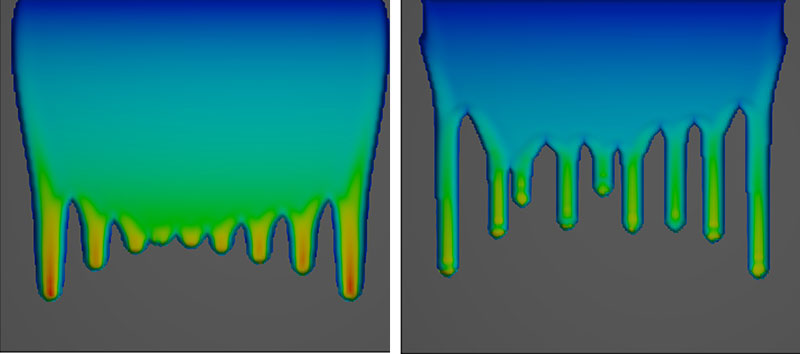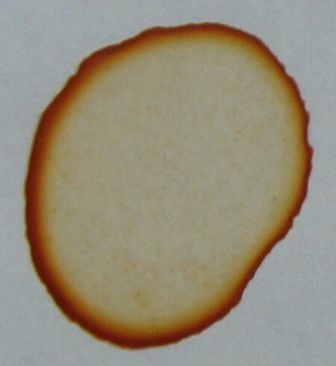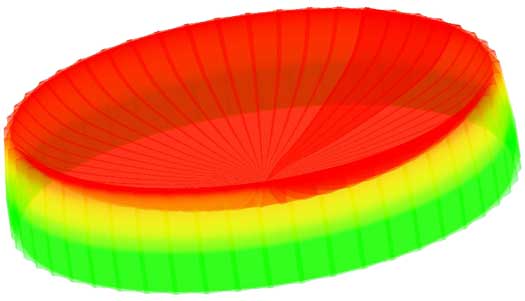
FLOW-3D‘s numerical modeling capabilities are ideal for engineers interested in improving coating performance. Computational simulation is an excellent way to study the relative importance and effect of different physical processes affecting coating flows. In physical tests it is not always possible to separate processes or arbitrarily adjust the magnitudes of those processes. In this section, we discuss FLOW-3D‘s treatment of static and dynamic contact angles in the context of rivulet formation, fingering, evaporation, contact-line movement over rough surfaces and fluid absorption.
Static and Dynamic Contact Angles
FLOW-3D can capture the hydrophobicity of a fluid by accurately computing the dynamic contact angle as a function of the static contact angle, set as an input, and the relevant forces acting at the free surface interface. The simulation below shows the effect that the static contact angle has on the dynamic contact angle as a droplet moves down an incline.
Absorption
The impact and absorption of a droplet onto a paper substrate can be studied with computational fluid dynamics software. In the droplet impact simulation, FLOW-3D is used to simulate droplet impingement on a fibrous bed, looking at the propagation of the fluid front as it relates to surface tension, contact angle, and viscosity. In the porous media simulation, the drop is 40 microns in diameter, with an initial downward velocity of 300 cm/s. The substrate is paper and is 20 microns thick with a given porosity of 30%.
Fingering in Liquid Films
In FLOW-3D, dynamic contact lines are modeled directly without the need to specify dynamic contact angles or the location of the contact lines. This is accomplished by using a numerical model that includes all the dynamic forces affecting fluid in small control volumes. Static contact angles are used to characterize liquid-solid adhesive forces.
An application of the power of this approach is given by the fingering observed in liquid films flowing down an inclined surface. Experimental observations show that two distinct patterns of fingering occur. One pattern, corresponding to small static contact angles (i.e., highly wetting conditions), exhibits wedge shaped fingers whose top and bottom limits both move downward. The second pattern, corresponding to large static contact angles (i.e., poorly wetting conditions), is characterized by long fingers of nearly uniform width whose top most limits are not moving downward.
Evaporative Effects
When liquid droplets containing dispersed solid material dry on a solid surface they leave the solid material as a deposit. The pattern of this deposit has important implications for many printing, cleaning and coating processes. A classic example of one type of deposit is the “coffee-ring” problem in which a ring stain is formed along the perimeter of a patch of spilled coffee, like the image on the left. This type of ring deposit develops as a consequence of surface-tension driven flows resulting from evaporation of liquid, particularly at the drop’s perimeter [1].
Drying
Drying is a critical part of the coating process; a well-applied coating can be completely undone by drying defects. During drying, temperature and solute gradients can drive flow within the coating due to density and surface tension gradients, which can potentially destroy the coating quality. FLOW-3D‘s evaporation residue model allows users to simulate drying-induced flows and reduces time spent on costly physical experimentation.
Modeling Ring Formation
FLOW-3D illustrates that edge pinning occurs because of deposition at a contact line where evaporation is greatest.Evaporation cools the liquid because of heat loss due to evaporation (color indicates temperature). At the same time the solid surface heats the liquid by conduction. Evaporation is greatest in the vicinity of the contact line, causing liquid to flow towards the contact line to reestablish static conditions. The net result is a deposition of suspended solid at the liquid edge where the liquid is completely evaporating.
Learn more about FLOW-3D‘s Contact Line Pinning model.




